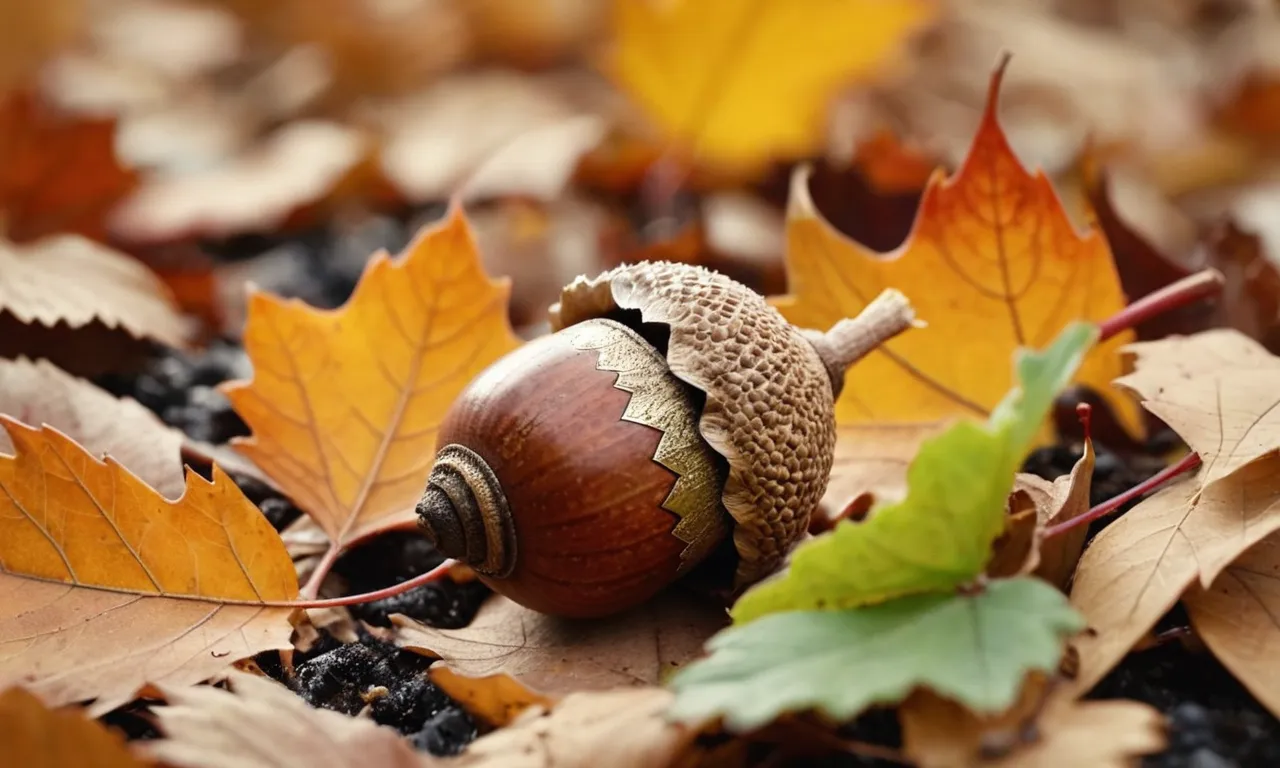Acorn Meaning: A Comprehensive Guide
Have you ever stumbled upon a small, brown, oval-shaped object on the ground and wondered what it was? Chances are, you’ve encountered an acorn – a humble yet fascinating natural wonder. Acorns are more than just a snack for squirrels; they hold a rich history, cultural significance, and ecological importance.
If you’re short on time, here’s a quick answer to your question: An acorn is a nut that grows on oak trees and serves as a seed for new oak trees to grow. It is a vital part of the oak tree’s life cycle and plays a crucial role in various ecosystems.
In this comprehensive article, we’ll delve into the fascinating world of acorns, exploring their meaning, history, uses, and ecological significance. We’ll also discuss the different types of acorns, their nutritional value, and their cultural relevance across various civilizations.
Whether you’re a nature enthusiast, a curious learner, or simply someone who appreciates the wonders of the natural world, this article will provide you with a wealth of information about these unassuming yet remarkable nuts.
What is an Acorn?
Definition and Description
An acorn is the nut-like fruit that grows on oak trees. It is a hard, oval-shaped seed with a smooth, leathery shell called a cupule or cap. The cap covers the lower portion of the acorn and is made up of woody, overlapping scales.
Acorns come in various shades of brown and can range in size from a few millimeters to several centimeters in length, depending on the oak species. They are a crucial part of the oak tree’s life cycle and serve as a source of food for many animals, including squirrels, deer, and birds.
The Life Cycle of an Oak Tree
The journey of an oak tree begins with a single acorn. When an acorn falls to the ground, it can germinate and sprout into a new oak seedling if the conditions are favorable. According to the United States Forest Service, it takes around 20 years for an oak tree to produce its first acorns.
Once established, a mature oak tree can produce thousands of acorns annually, with peak production occurring every 4-10 years in a phenomenon known as a “mast year.” 😮 The life cycle of an oak tree can span several centuries, with some species living up to 500 years or more!
Types of Acorns
There are numerous varieties of acorns, each with its unique characteristics. Here are some common types:
- Red Oak Acorns: These acorns have a distinctive reddish-brown color and are larger than many other types. They have a bitter taste due to higher levels of tannins.
- White Oak Acorns: These acorns are lighter in color and have a sweeter, less bitter taste, making them more palatable for wildlife and humans.
- Bur Oak Acorns: Known for their distinctive fringed cap, these acorns are large and have a sweet flavor.
- Live Oak Acorns: Found on evergreen oak trees, these acorns are smaller and oval-shaped, with a thin cap.
Did you know that some Native American tribes, such as the Hopi and Navajo, have traditionally used acorns as a valuable food source? 🤔 They developed techniques to leach out the bitter tannins, allowing them to grind the acorns into flour for baking or making porridge. Isn’t that amazing? 😍
Whether you’re a nature enthusiast, a forager, or simply curious about the world around you, understanding the significance of acorns is a fascinating journey into the intricate web of life. These small, unassuming fruits play a vital role in sustaining ecosystems and have been cherished by humans for centuries as a valuable food source and symbol of strength and resilience.
Historical and Cultural Significance of Acorns
Acorns in Ancient Civilizations
Acorns have played a pivotal role in the sustenance and cultural traditions of numerous ancient civilizations across the globe. For thousands of years, these humble nuts have been a valuable food source, particularly for indigenous communities living in oak-rich regions.
The ancient Greeks, Romans, and Native Americans heavily relied on acorns as a dietary staple, processing them through various methods to remove their bitter tannins and render them edible. According to the US Forest Service, acorns were a crucial part of the diet for many Native American tribes, providing up to 50% of their caloric intake during certain seasons.
Acorns in Folklore and Mythology
Beyond their practical applications, acorns have also woven their way into the rich tapestry of folklore and mythology across diverse cultures. In ancient Greek mythology, the oak tree was sacred to Zeus, the king of the gods, and acorns were believed to be a symbol of his power and authority.
In Celtic mythology, the oak tree and its acorns were revered as symbols of strength, endurance, and fertility, playing a significant role in various rituals and celebrations. Similarly, in Germanic folklore, the oak tree was considered a sacred tree, and its acorns were believed to possess magical properties, often used in divination practices.
Acorns as a Symbol
Throughout history, acorns have transcended their humble origins to become potent symbols in various contexts. In heraldry, the acorn has been a prominent motif, representing strength, fertility, and perseverance.
It has been incorporated into numerous family crests and coats of arms, symbolizing the enduring legacy and resilience of noble lineages. According to the Encyclopedia Britannica, the acorn has also been a symbol of good luck, prosperity, and youth in various cultures.
😊 In modern times, acorns have become emblematic of environmental conservation efforts, serving as a reminder of the importance of preserving and protecting our natural resources for future generations.
Throughout the ages, acorns have held profound significance, transcending their humble origins to become symbols of strength, fertility, and enduring legacy. From sustaining ancient civilizations to inspiring mythological tales and heraldic emblems, these unassuming nuts have left an indelible mark on human history and culture.
Their enduring symbolism serves as a testament to the enduring bond between humans and nature, reminding us of the profound wisdom and resilience that can be found in the most humble of sources. 👏
Ecological Importance of Acorns
Acorns, the nutrient-rich fruits of oak trees, play a vital role in sustaining diverse ecosystems. Their ecological significance extends far beyond their humble appearance, making them a crucial component of the natural world.
Let’s delve into the remarkable ways acorns contribute to the well-being of our forests and wildlife.
Acorns as a Food Source
Acorns serve as a valuable food source for a wide array of animals, from small mammals like squirrels and chipmunks to larger creatures like deer, bears, and even birds. According to the U.S. Department of Agriculture, a good acorn crop can provide up to 25% of the annual food supply for some wildlife species.
This abundance of food not only sustains these animals but also supports their reproductive success and overall population health.
Role in Forest Ecosystems
Beyond their nutritional value, acorns play a pivotal role in the regeneration and maintenance of oak forests. When acorns germinate, they give rise to new oak seedlings, ensuring the continuation of these majestic trees for generations to come.
This process is crucial for maintaining the biodiversity of oak-dominated ecosystems, which provide habitat for countless species of plants, insects, birds, and other wildlife. Furthermore, the decomposition of acorn husks and shells contributes valuable organic matter to the soil, enriching it with essential nutrients for the growth of other plants and fungi.
Acorns and Wildlife Conservation
The importance of acorns extends to wildlife conservation efforts. Many species, such as the endangered Delmarva fox squirrel, rely heavily on acorn crops for their survival. According to the U.S. Fish and Wildlife Service, a poor acorn crop can significantly impact the population of this species.
Conservation organizations like the Nature Conservancy work to protect and restore oak forests, ensuring a steady supply of acorns for the wildlife that depends on them. This effort not only safeguards individual species but also contributes to the overall health and resilience of entire ecosystems.
Nutritional Value and Uses of Acorns
Nutritional Composition of Acorns
Acorns, the humble nuts produced by oak trees, are a treasure trove of nutrients. These small powerhouses are packed with carbohydrates, protein, and healthy fats, making them a nutritious addition to any diet.
According to Nutrition and You, a single ounce of dried acorns contains approximately 110 calories, 4 grams of protein, 18 grams of carbohydrates, and 6 grams of fat. They are also a good source of dietary fiber, providing around 2 grams per ounce.
But the real star of the show is the impressive mineral content of acorns. They are an excellent source of manganese, providing over 60% of the recommended daily intake in just one ounce. Manganese is essential for bone health, metabolism, and antioxidant defense.
Acorns are also rich in copper, iron, and zinc, making them a fantastic addition to a plant-based diet.
Traditional Uses of Acorns
For centuries, indigenous communities around the world have relied on acorns as a staple food source. Native Americans, particularly those in California, have a long history of harvesting and processing acorns for various culinary purposes.
They would grind the acorns into flour, leach out the bitter tannins, and use the resulting meal to make bread, porridge, or even a type of coffee-like beverage. Can’t you just imagine the aroma of freshly baked acorn bread wafting through a traditional village? 😍
Beyond their role in sustenance, acorns have also been used for medicinal purposes. Some Native American tribes would prepare acorn decoctions to treat various ailments, such as stomach issues, skin conditions, and even respiratory problems.
This speaks volumes about the versatility and significance of acorns in traditional cultures.
Modern Uses and Products
In recent years, there has been a resurgence of interest in acorns, driven by their nutritional value and eco-friendly potential. Many health-conscious individuals have started incorporating acorn flour into their diets, using it to make gluten-free baked goods, pasta, and even pancakes.
Doesn’t that sound awesome? 👏
Moreover, acorns are being explored as a sustainable source of oil, which can be used in cooking, cosmetics, and even biofuel production. Companies like Oak Naturals are leading the charge in this area, offering a range of acorn-based products that are not only delicious but also environmentally friendly.
So, whether you’re a health enthusiast, a culinary adventurer, or an eco-warrior, acorns have something to offer. With their impressive nutritional profile and versatile applications, these humble nuts are truly a gift from nature that deserves our attention and appreciation.
Acorn Trivia and Fun Facts
Interesting Acorn Trivia
- Acorns are the fruit of oak trees, and each one contains a single seed or nut. They come in a variety of shapes and sizes, from the tiny acorns of the willow oak to the massive acorns of the valley oak.
- Acorns are a staple food source for many animals, including squirrels, chipmunks, deer, bears, and even some birds like jays and woodpeckers. According to the U.S. Forest Service, acorns were also a significant part of the diet for many Native American tribes.
- Oak trees can produce hundreds or even thousands of acorns in a single year, a phenomenon known as a “mast year.” This abundance of food helps support larger populations of wildlife.
- The acorn cap, or cupule, is a woody structure that protects the acorn as it grows. Some species, like the bur oak, have caps that completely cover the acorn, while others, like the red oak, have caps that only partially cover the acorn.
Acorn-Related Idioms and Expressions
Acorns have found their way into several idioms and expressions in the English language, reflecting their cultural significance:
- “From little acorns mighty oaks grow” – This phrase suggests that great things can come from small beginnings.
- “Squirreling away acorns” – This expression refers to the act of saving or storing things for future use, much like squirrels do with acorns.
- “Gathering acorns” – This idiom means to collect or accumulate things, often in preparation for a future event or need.
Acorn-Inspired Art and Literature
Acorns have also been a source of inspiration for artists and writers throughout history:
- In the children’s book “Tops and Bottoms” by Janet Stevens, a clever hare outsmarts a lazy bear by planting acorns to grow oak trees and claiming the tops (the acorns) for himself.
- The famous American poet Emily Dickinson wrote a poem titled “The Acorn Breast,” which compares the shape of an acorn to a human breast.
- Acorns have been featured in various forms of art, including sculptures, paintings, and jewelry designs. For example, the Museum of Modern Art in New York City has an acorn sculpture by the artist Isamu Noguchi in its collection.
Whether you’re a nature lover, a wordsmith, or an art enthusiast, acorns offer a wealth of fascinating trivia and creative inspiration. From their role in sustaining wildlife to their symbolic meanings in language and art, these humble nuts have left an indelible mark on human culture and imagination.
So the next time you come across an acorn, take a moment to appreciate its significance and the many stories it has to tell.
Conclusion
Acorns may seem like small, insignificant objects, but their impact on the natural world and human culture is truly remarkable. From their vital role in the life cycle of oak trees to their historical and cultural significance, acorns have captivated the minds of people for centuries.
Throughout this comprehensive guide, we’ve explored the fascinating world of acorns, delving into their definition, types, ecological importance, nutritional value, and cultural relevance. We’ve learned about their role as a food source for wildlife, their symbolism in ancient civilizations, and their potential modern uses and products.
As we continue to appreciate and understand the wonders of nature, let us not overlook the humble acorn. These small nuts hold a wealth of knowledge and significance, reminding us of the intricate connections between the natural world and human societies.
Whether you’re a nature enthusiast, a curious learner, or simply someone who appreciates the beauty in the smallest of things, the acorn will forever remain a remarkable and captivating natural wonder.








